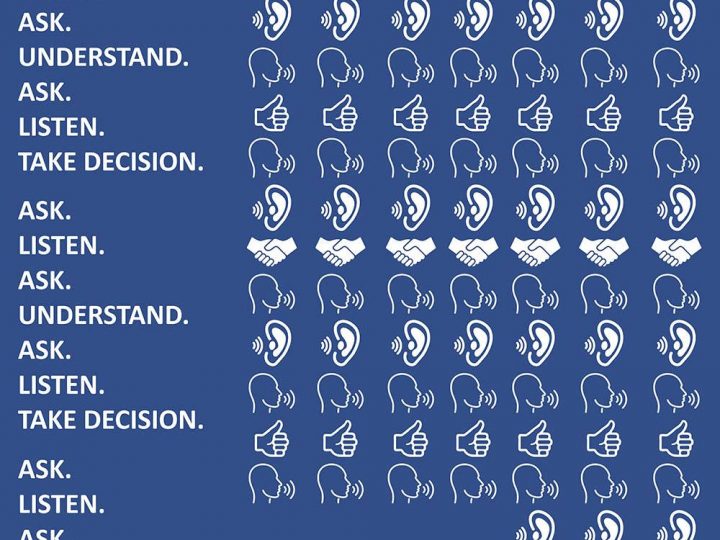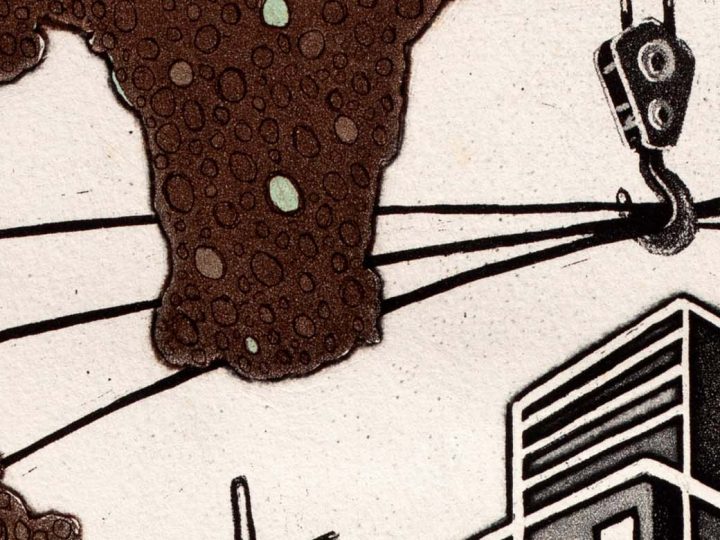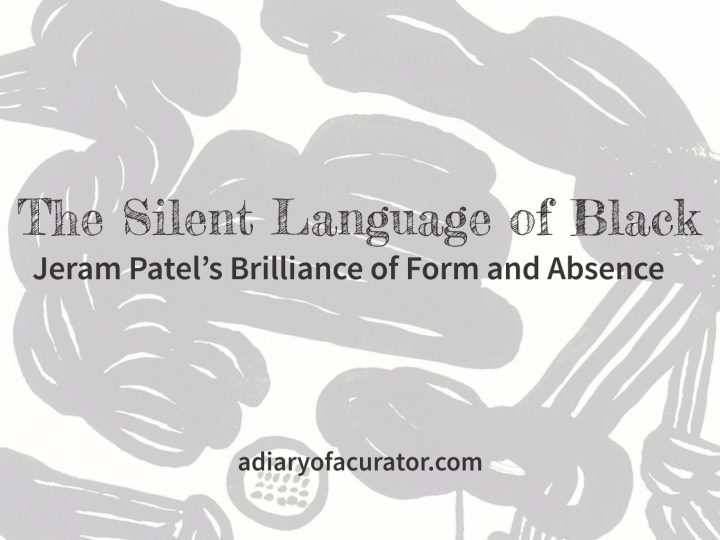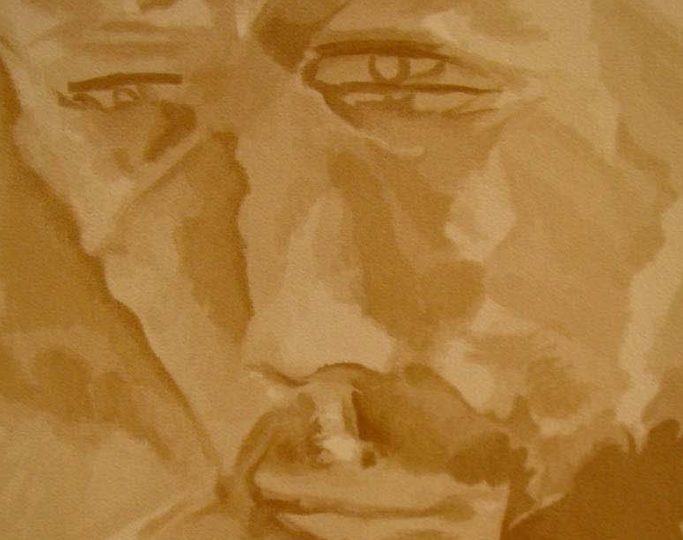Dada of Indian Art | MF Husain
For some Husain is a maharaja. For others a king. For many he is a dada, a grandfather who nurtures children, leaves a legacy a family can cherish for generations, and works for the betterment of society.
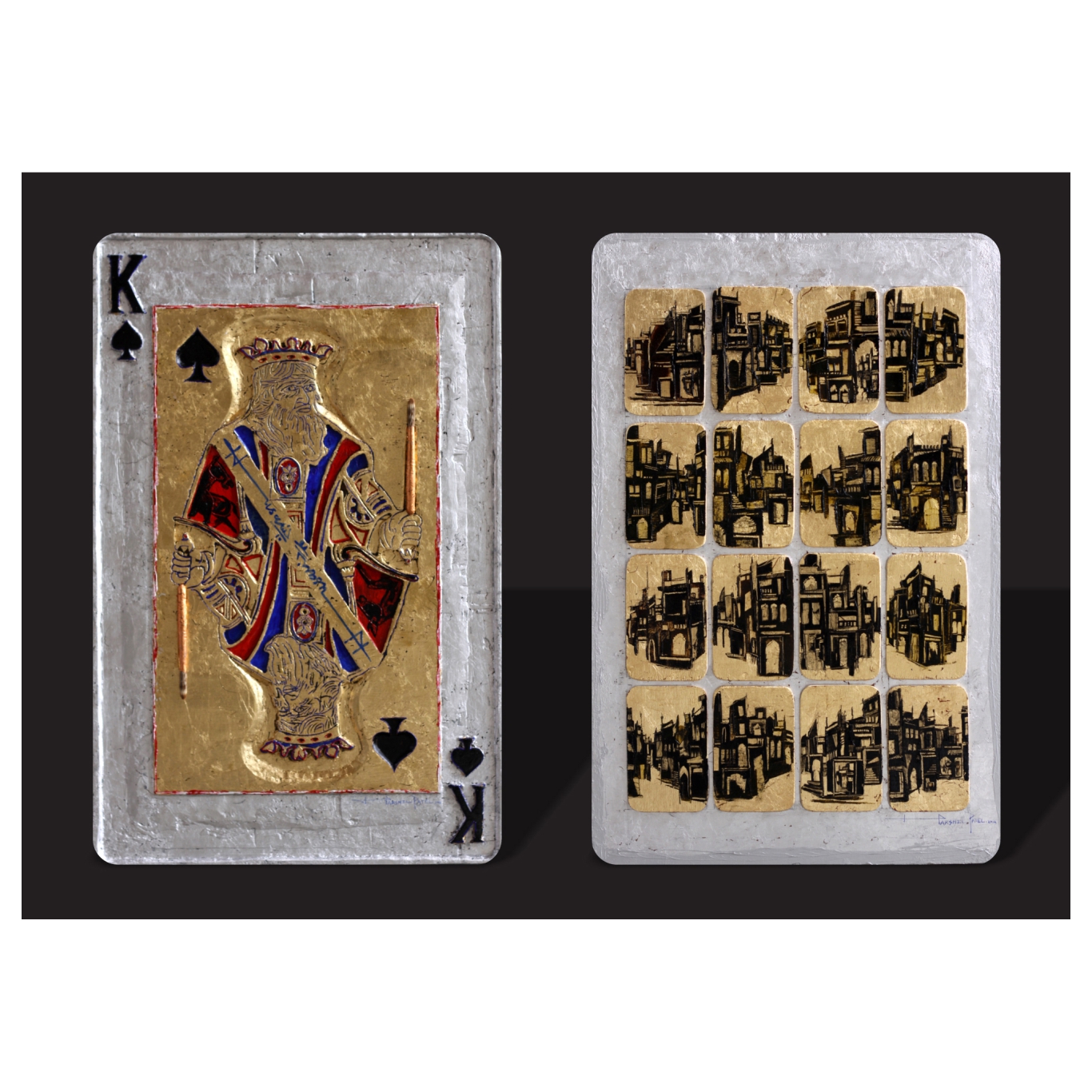
Game of Art World by Harshil Patel
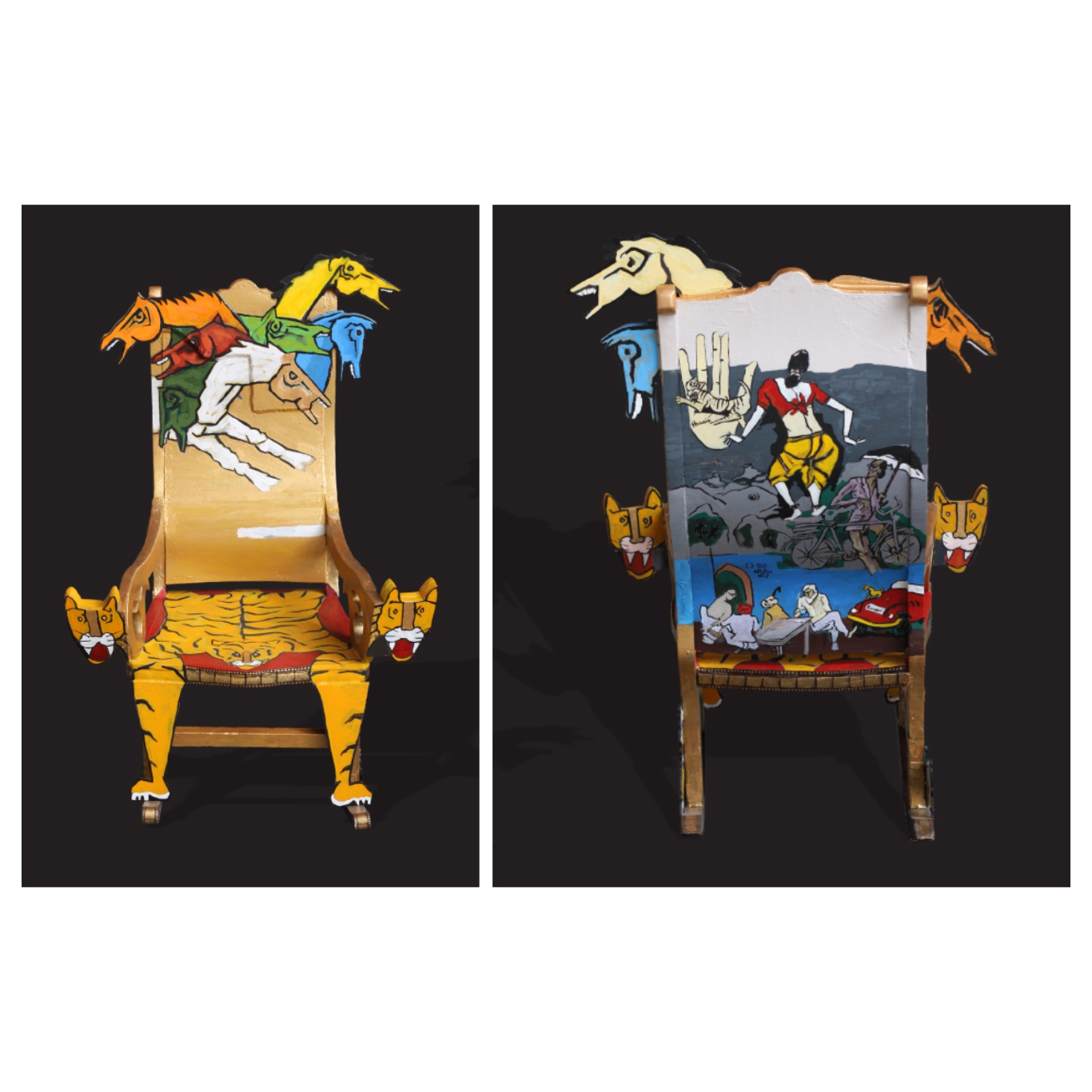
Touch...Feel...Believe by Sachin Nimbalkar
The Picture I Carry of MF Husain
When the name Husain comes up, I begin with a picture. A white kurta pyjama. A white beard. Tinted glasses. Hands that are soft yet energetic. Quick movements. A little restlessness and constant motion. In that restlessness lived many ideas. Colours flashed before him and he registered them in an instant. He kept asking himself when he would paint and where he should paint. A horse, a table, a bottle, a computer, a sheet of paper. He was always ready at the word Go. Any material. Any object. Only when he could move the thousands of ideas in his mind onto a surface did he find peace. That is my first impression whenever I recollect Husain.
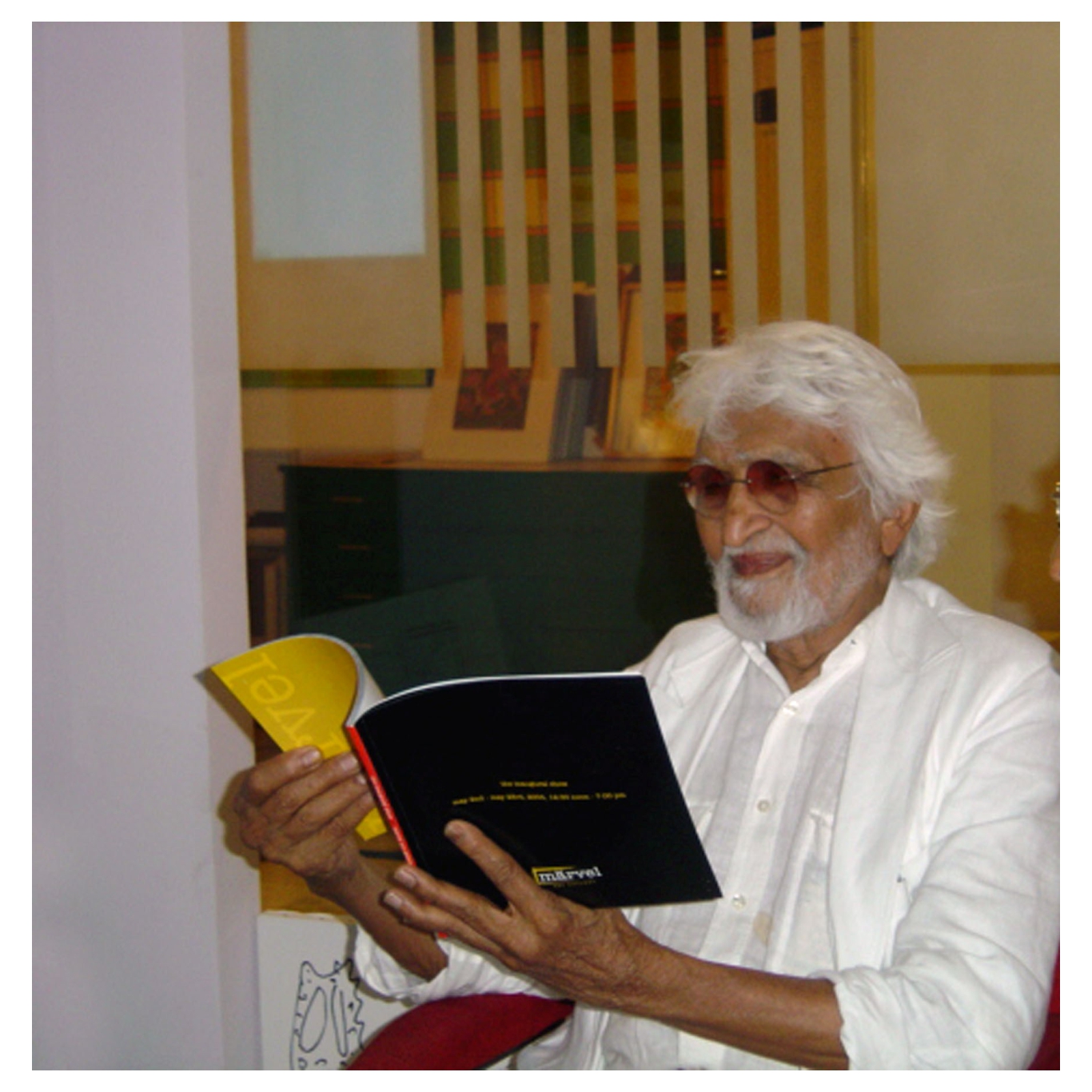
MF Husain at DRS Arts Company (formerly Marvel Art Gallery), mid-2000s
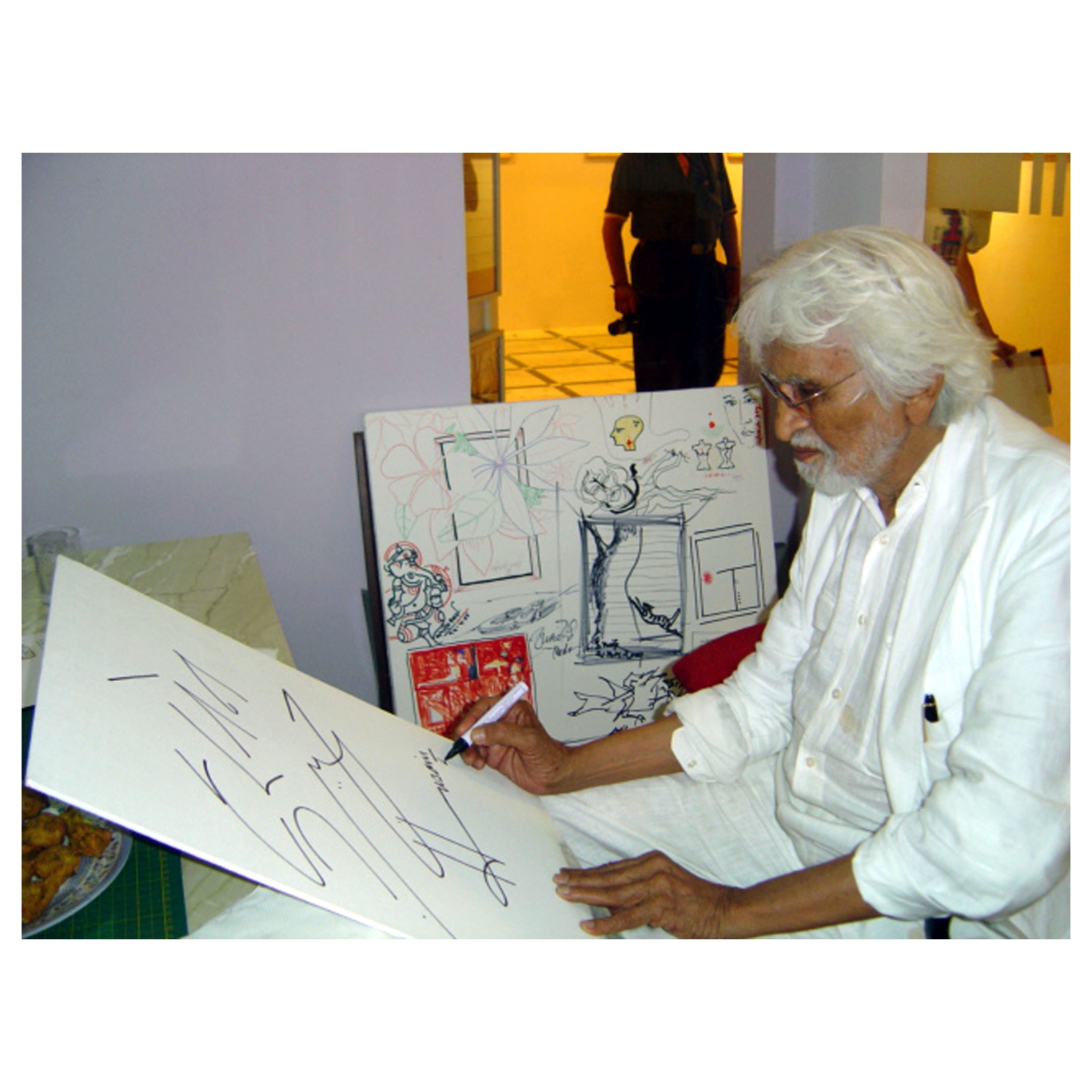
MF Husain at DRS Arts Company (formerly Marvel Art Gallery), mid-2000s
Restless ideas that become images
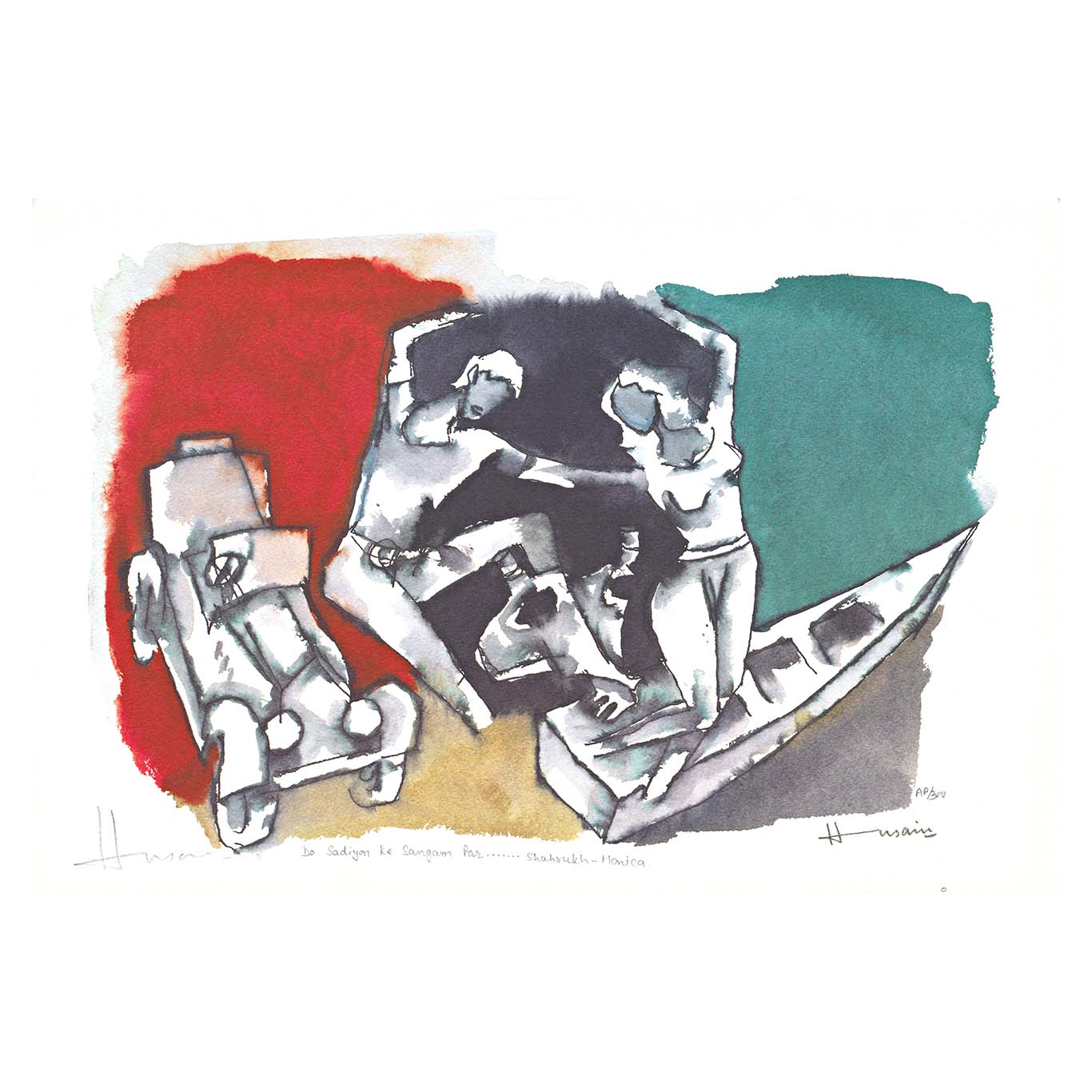
Shahrukh Khan & Madhuri Dixit in Gaja Gamini, Artwork by MF Husain
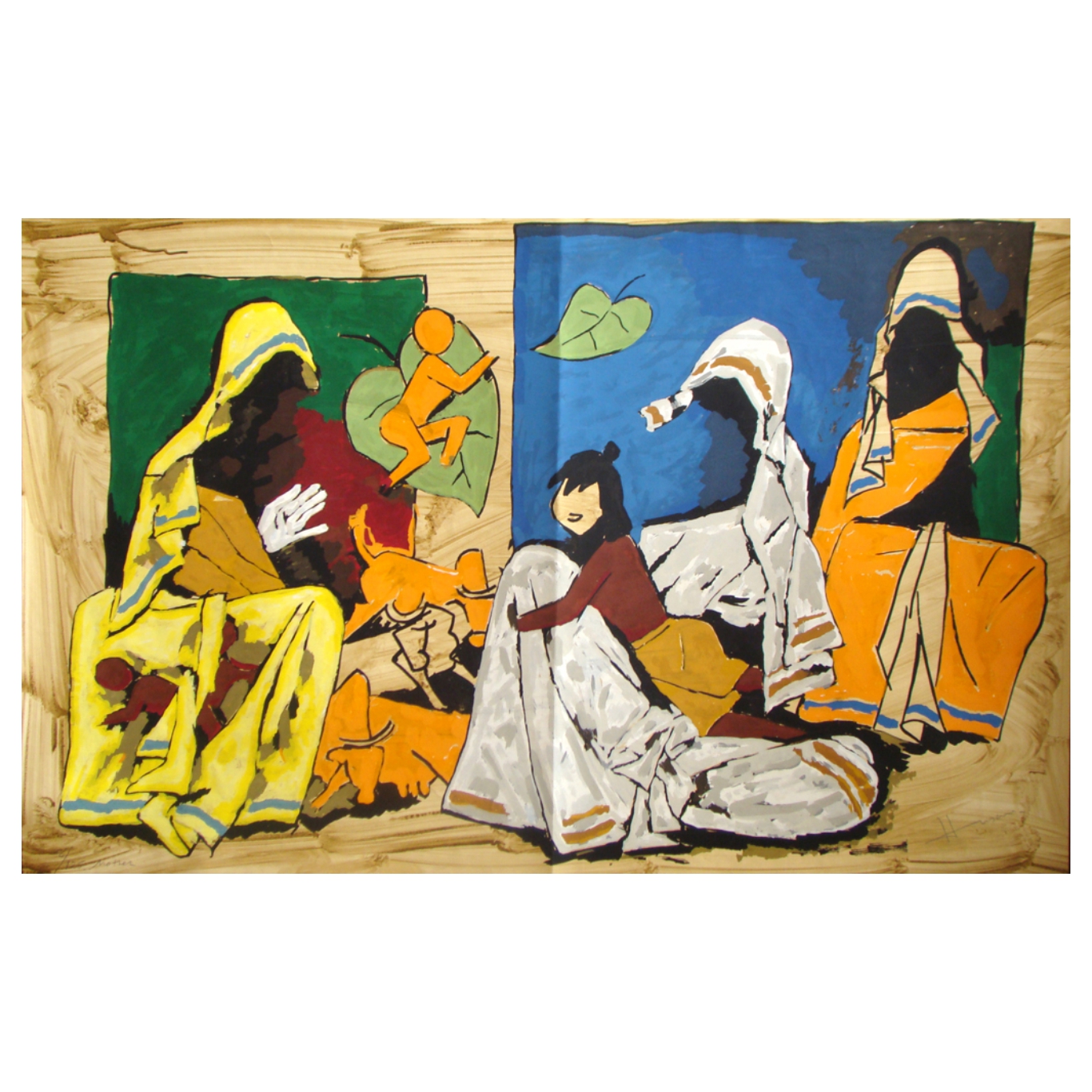
Mother Teresa by MF Husain, 40 x 60 in, Serigraph on Paper, 2001
My second memory is the artist at full span. Fearless and experimental. An innovator who worked across subjects and mediums. He painted cinema posters to survive. He directed artful films with Madhuri Dixit, Shah Rukh Khan and Yash Chopra. He did serigraphs when most artists never considered the medium. He breathed art in India and kept India at the centre of his work.
Three clear impressions that shaped me
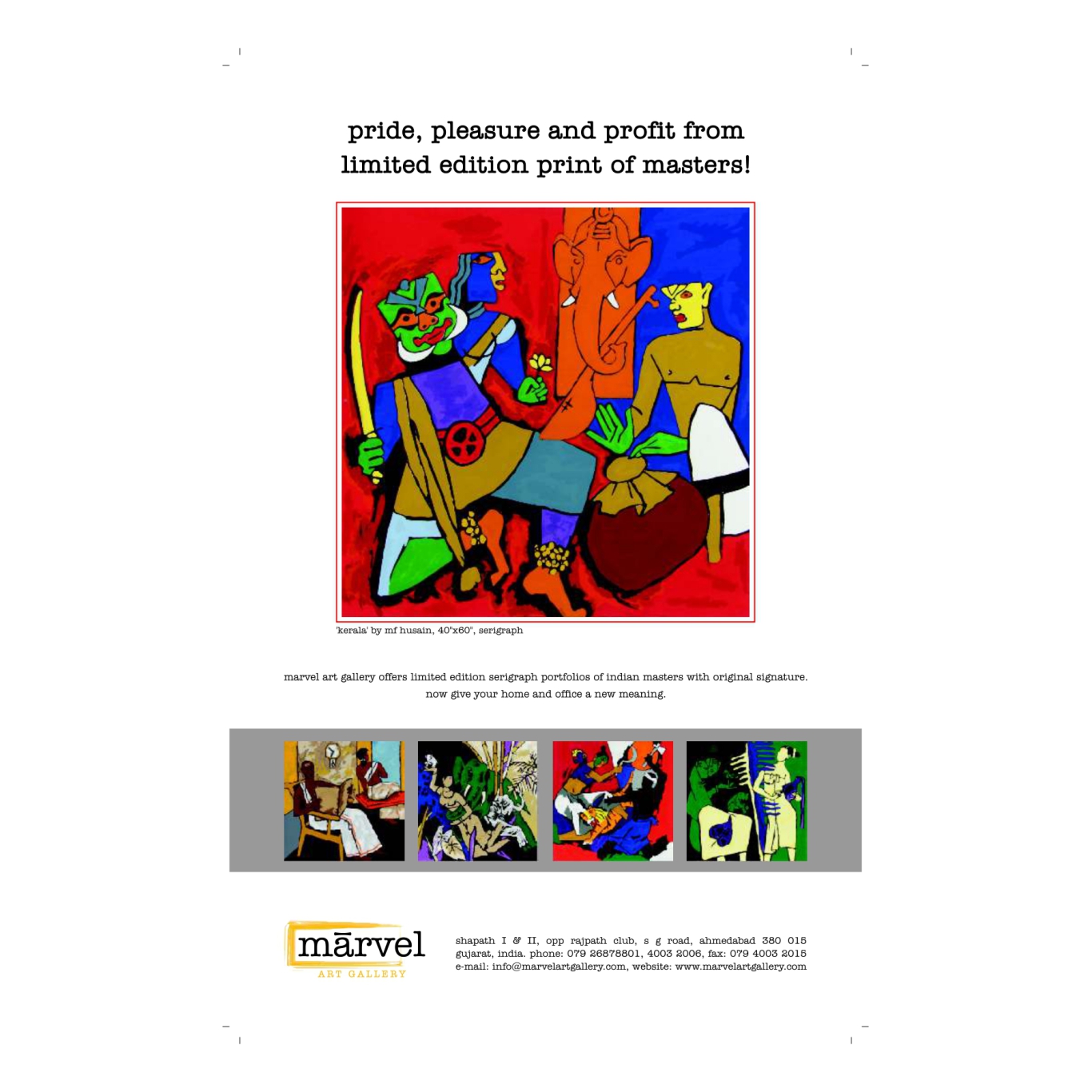
Advertisement in Art India magazine, mid-2000s
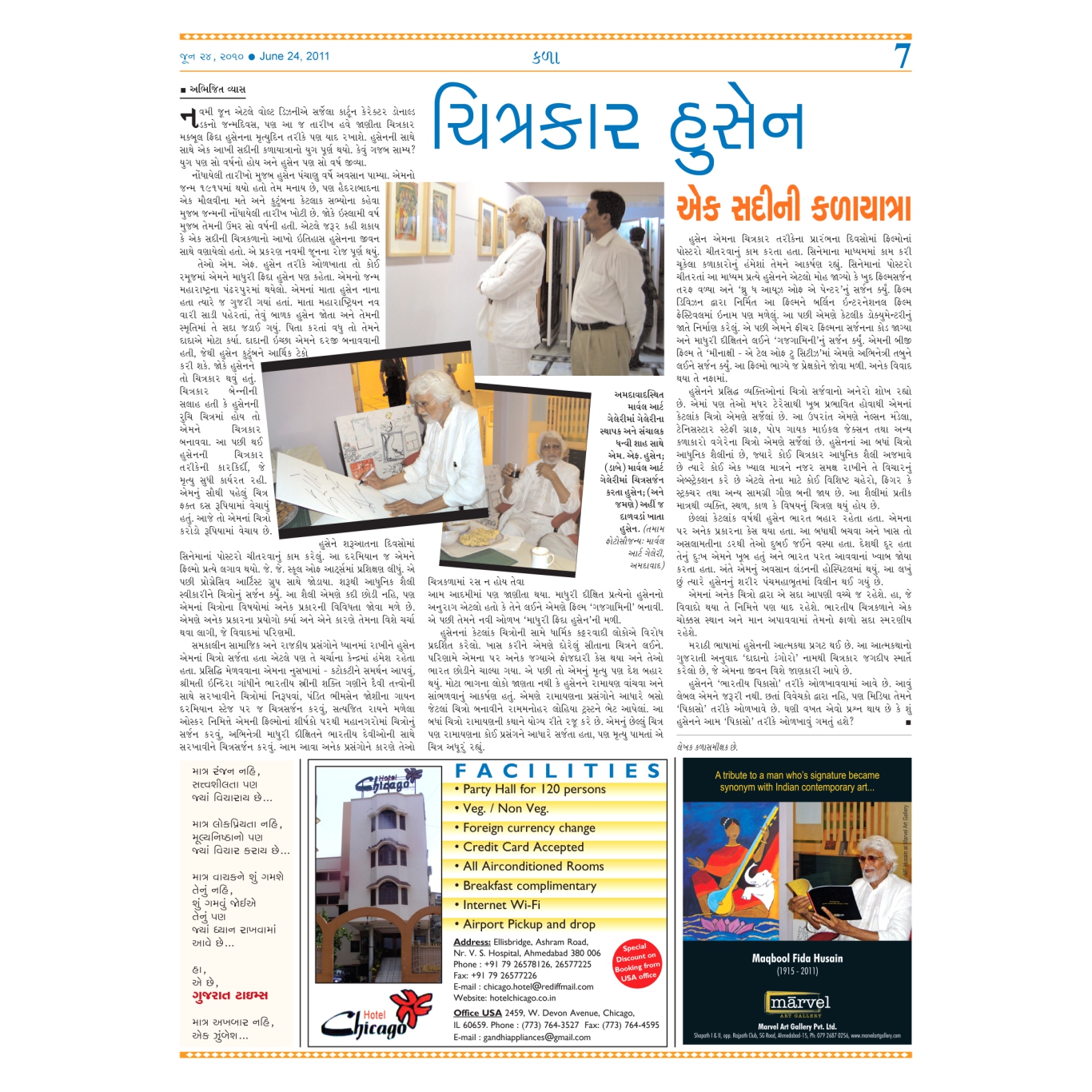
Chitrakar Husain - Ek Sadi ni Kala Yatra by Abhijit Vyas, Gujarat Times, 2011
My last impression is just as clear. He carried Indian art to the world and returned India to Indians. He re energised the art market, including in financial terms. My first memory is his excitement and restlessness. My second is his subjects, research and knowledge. My third is his contribution to the Indian art world.
A first doorway
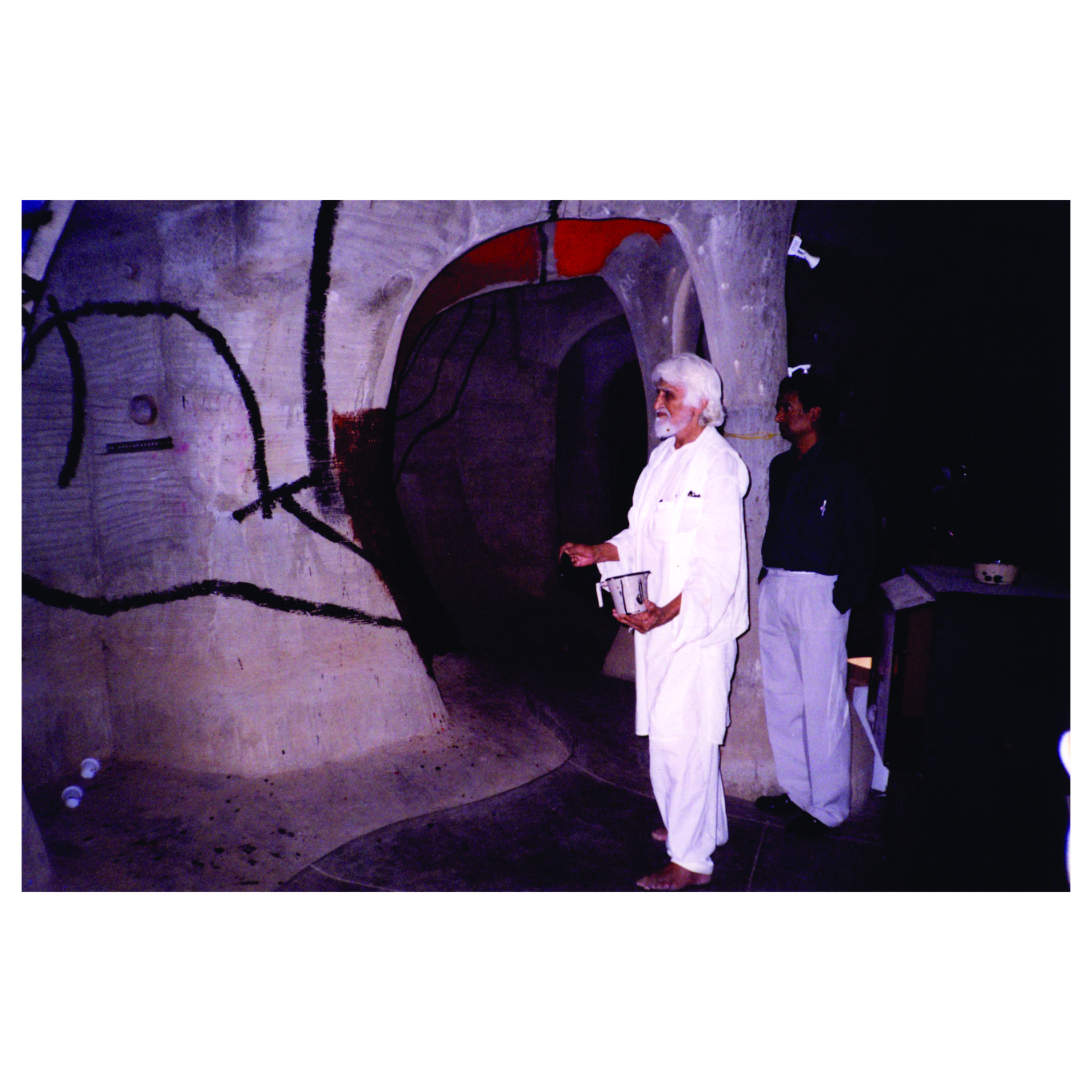
MF Husain with Dhanvi Shah during the making of Amdavad ni Gufa in the mid-1990s
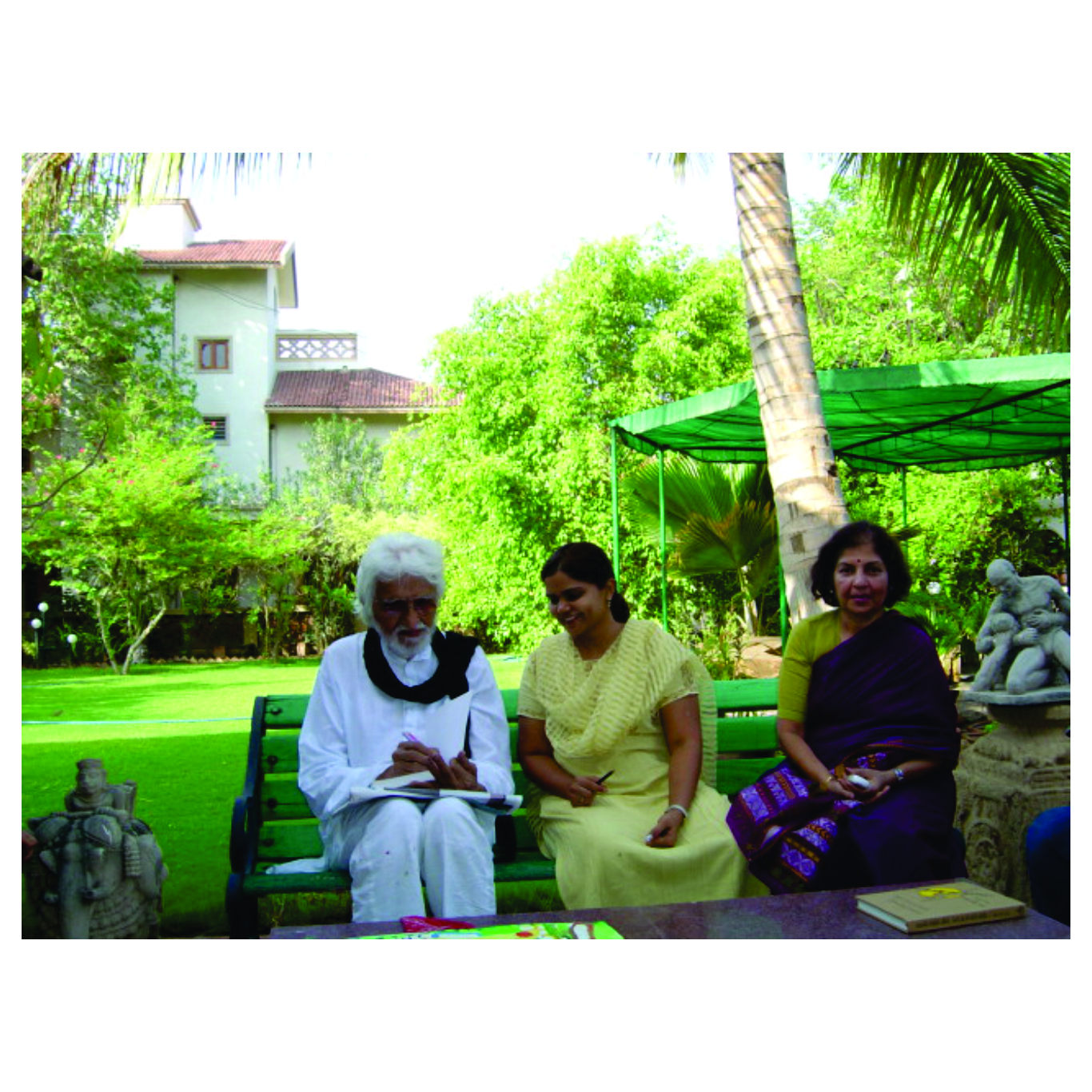
Jyoti Dhanvi Shah with legendary artist M.F. Husain in the mid-2000s
I was in school when I first heard my father speak about him. He once took me to the construction of the now famous Amdavad ni Gufa, created by Husain with the legendary Pritzker Prize laureate Balkrishna Doshi in the mid 1990s.
Meeting the man in the early two thousands
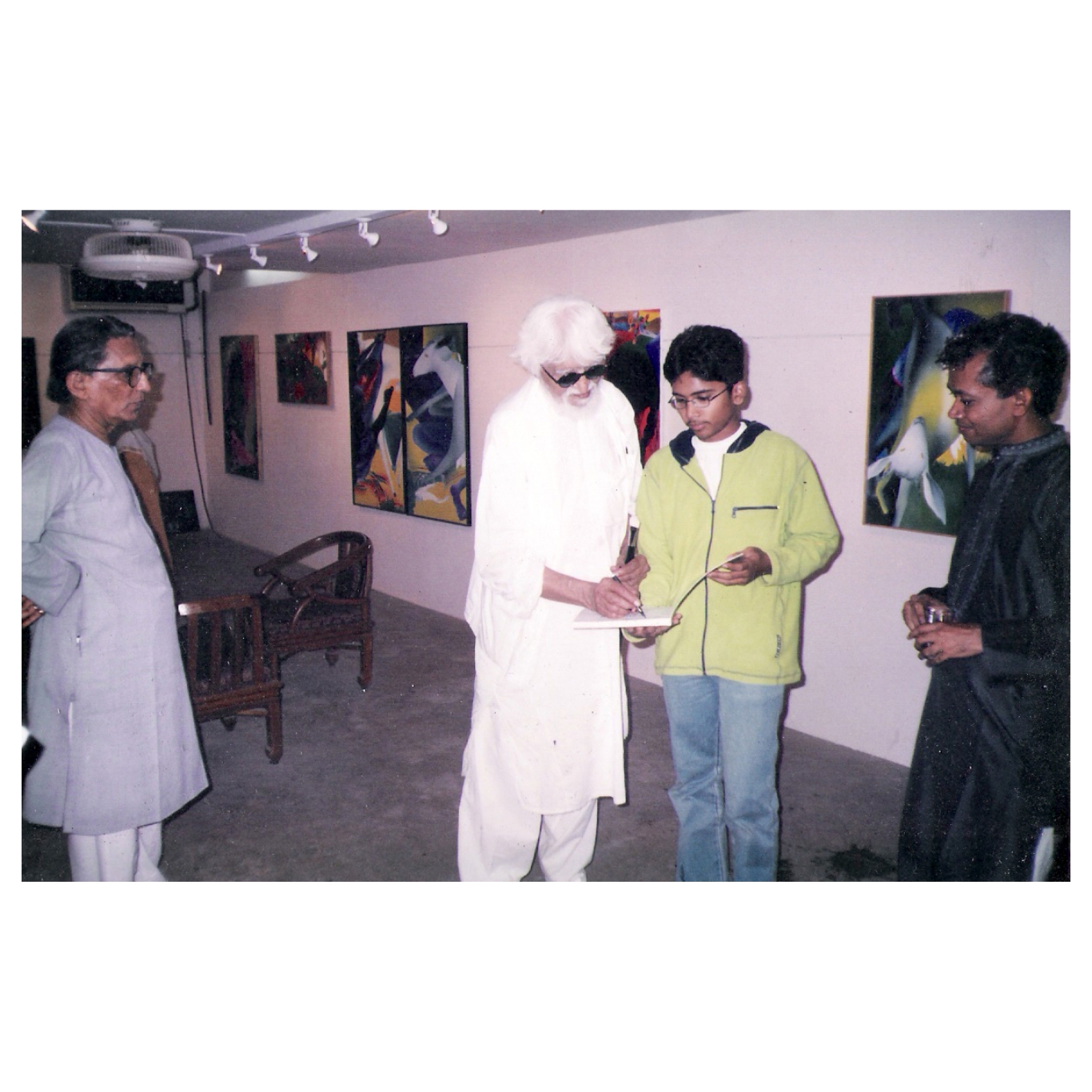
Chaitya Dhanvi Shah with MF Husain in Ahmedabad, early 2000s, joined by Balkrishna Doshi (L) and Nabibaksh Mansoori (R)
In the early 2000s I met Husain at the gallery. I wore an SRK-style Kuch Kuch Hota Hai jacket to impress him. Another memory is from 2003–04, when he was shooting Meenaxi and there was a chance to visit the set. Silly me, I coloured my hair to look smart, secretly hoping he might offer me a shot in the film. The funny part is that nothing of the sort happened. Being on the set itself was a dream, watching him direct with art sets, costumes and art everywhere. My principal caught me for the hair colour, which was banned in school, and I received strict punishment.
Signature, colour and how to read a picture
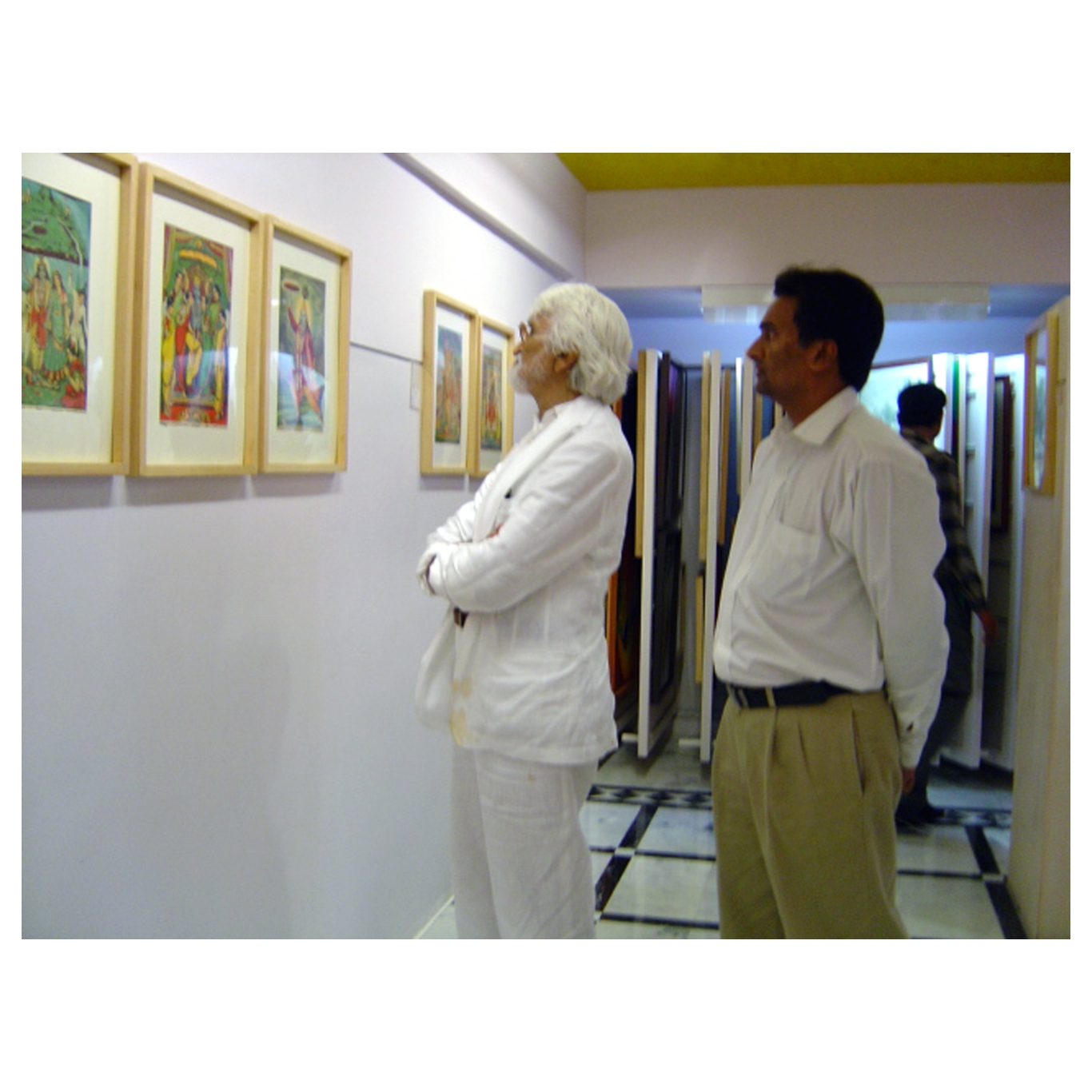
MF Husain at DRS Arts Company, taking in oleographs from the Raja Ravi Varma Press, joined by Dhanvi Shah
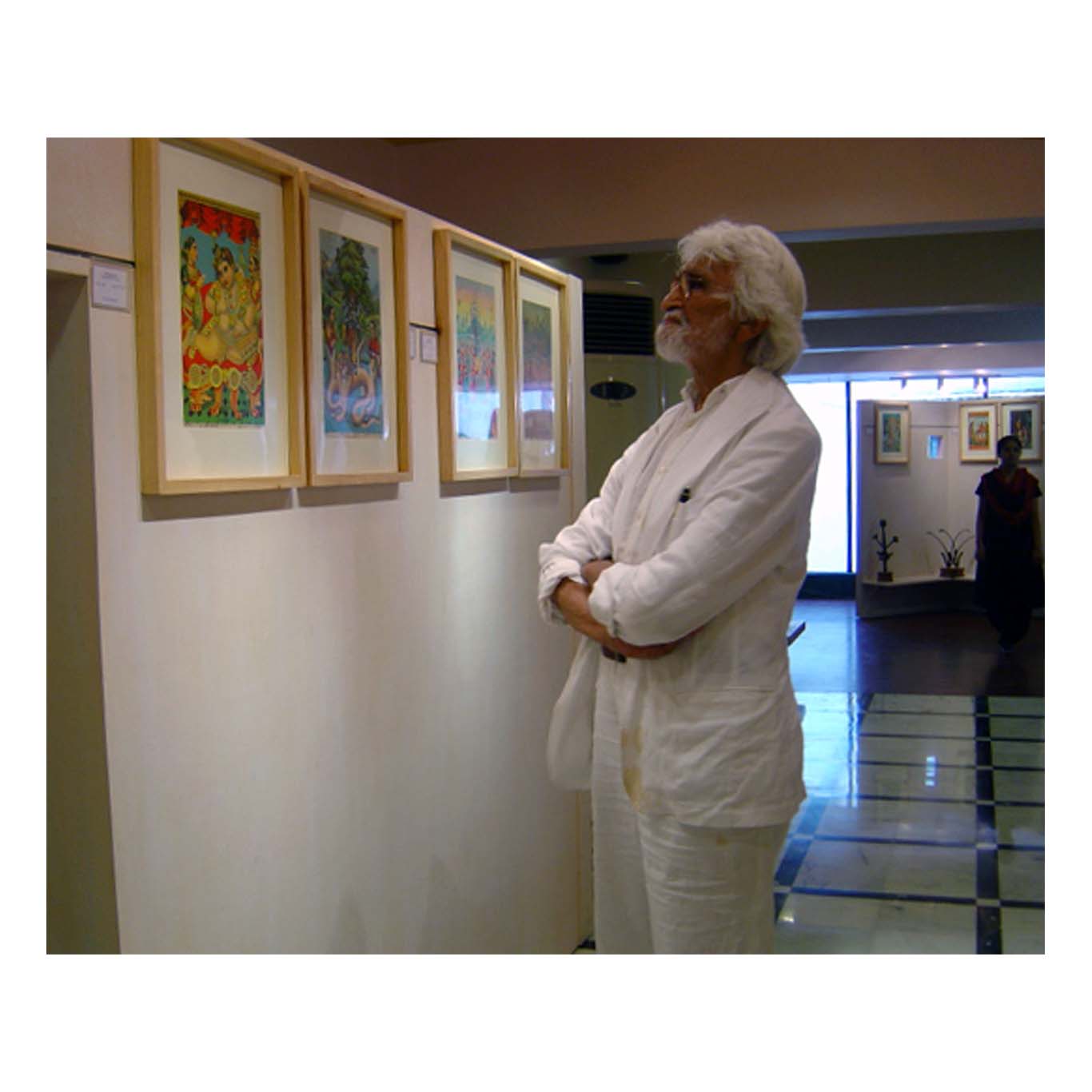
Legend MF Husain enjoying oleographs from the Raja Ravi Varma Press at DRS Arts Company (formerly Marvel Art Gallery)
There came a time when my connection with Husain’s work became integral. His vibrant colours, defining lines and narrative pull. Episodic pictures that felt catchy, unique and easy to read. A signature style and, just as important, the signature itself. I painted too, and I was obsessed with his flow and the presence of that strong signature. A painting felt complete when the big H began and the straight line ran into “Husain”. It was like a film credit with Lata Mangeshkar or Kishore Kumar. You knew there would be classic hits. I was so engrossed in the artworks around us at the gallery that it was hard to step away. His artworks made the subject more interesting to learn through looking. Through him I learned how to read art and how to read people.
Taking art to people across India
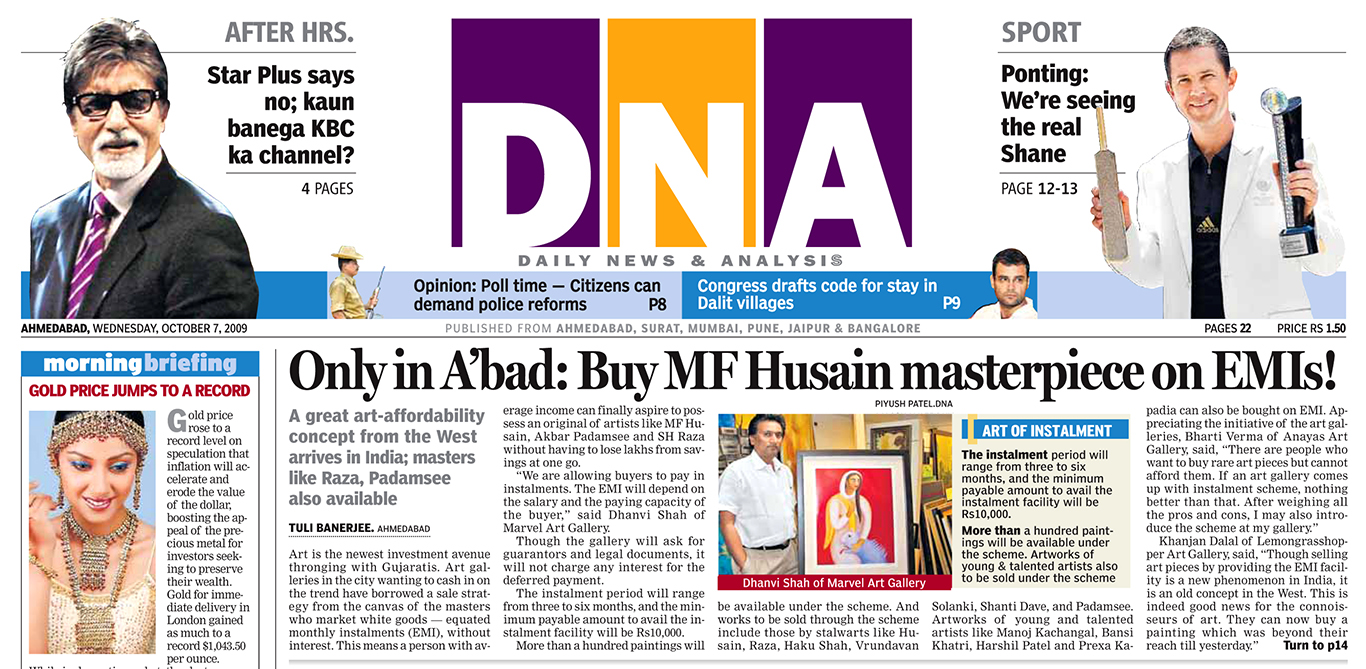
Only in A’bad: Buy MF Husain masterpiece on EMIs! By Tuli Banerjee. DNA Daily News & Analysis, Ahmedabad Edition. Published on October 7, 2009
Working with Husain’s editions was a pleasure. We advertised, wrote in newspapers and made his work more accessible through EMI. We promoted his ideas and the legend he was. People wanted to know everything. His lifestyle. His thought process. His cinema connections. His admiration for Madhuri. His love for movies, horses and Mother Teresa. There was a wave around him and I realised that no other artist, even over a longer period, could claim what everyone already knew. By 2007, from the rickshawala to the leading industrialist, India knew Husain and wanted to collect Husain. At that time India had one legendary artist, and that was Husain. From one to ten he filled the scale. He made Indian art commercial without losing its depth, approachable without losing its value, and he pioneered the marketing of Indian art. It is a big claim, but he had a ninety percent role in that change.
There is also a quiet gallery memory from before he left for Dubai and, regretfully, never returned. He signed a canvas while enjoying oleographs from the Raja Ravi Varma Press and looking at his original works that we exhibited at our 2004 inaugural. It is one of my most cherished memories of him in person. Looking back, I feel fortunate to have seen the artist who gave a foundation to modern and contemporary Indian art enjoy the artist who gave Indian art its face, and to witness it at our newly inaugurated gallery. For any art lover, that is both dream and pilgrimage.
Tribute, loss and a public salute
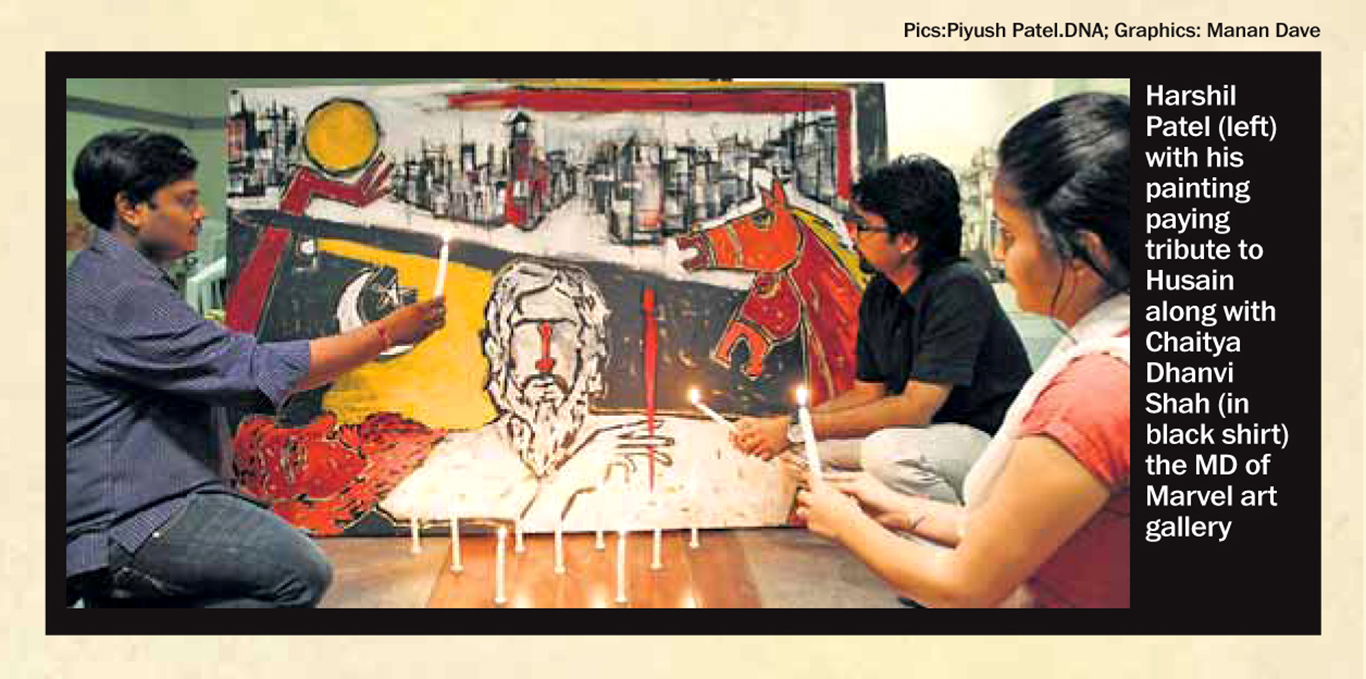
Tribute to Husain. Harshil Patel (left) with his painting, with Chaitya Dhanvi Shah (in black), MD of Marvel Art Gallery. DNA Daily News & Analysis. Published on June 10, 2011. Photo: Piyush Patel. Graphics: Manan Dave
His passing in 2011 remains one of the most shocking moments of my life. We lost Husain. The shock came from my deep involvement with art, and from the fact that he was in exile after all he had done for the country. It also came from what he had done for Indian art and the market. We created a painting for him with the artist Harshil Patel, who was equally passionate about Husain and his legacy. There were horses and lines. Husain as king. Empty streets that spoke of how his absence was felt and how his influence filled the world. Red stood for his passion and the lifeblood he gave to art.
We honoured his contribution with a public tribute to the man whose signature had become synonymous with Indian contemporary art. It ran across leading English and Gujarati newspapers. As far as I know, nothing like it had happened in Gujarat for any artist. A private gallery acknowledged him before the larger society so that everyone could see how important he was to us and to Indian art. It remains one of our most memorable acts.
A year later we presented his contribution to a wider audience beyond the art fraternity. In 2012 we exhibited Husain Through the Eyes of Painters, a title inspired by his documentary Through the Eyes of a Painter. The participating artists were Bansi Khatri, Harshil Patel, Nipa Modi, Preksha Kapadia, Prithviraj Mali, Sachin Nimbalkar and Sajal Sasanka Sarkar. They each painted Husain through their own eyes. The response was warm and strong, and the gallery remains grateful to them. Leading English and Gujarati media covered the exhibition and its ideas.
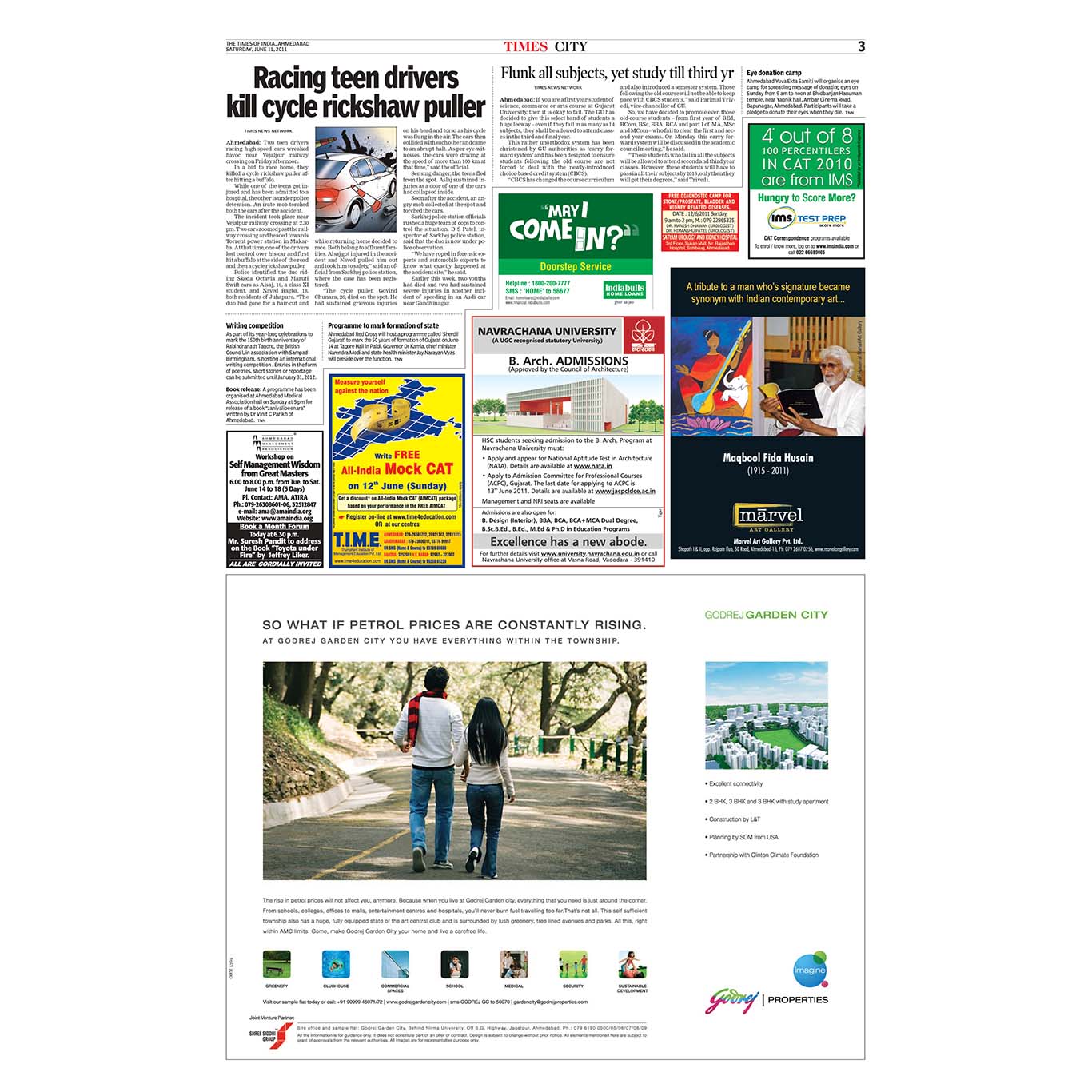
Maqbool Fida Husain remembered. The Times of India, Ahmedabad, 11 June 2011
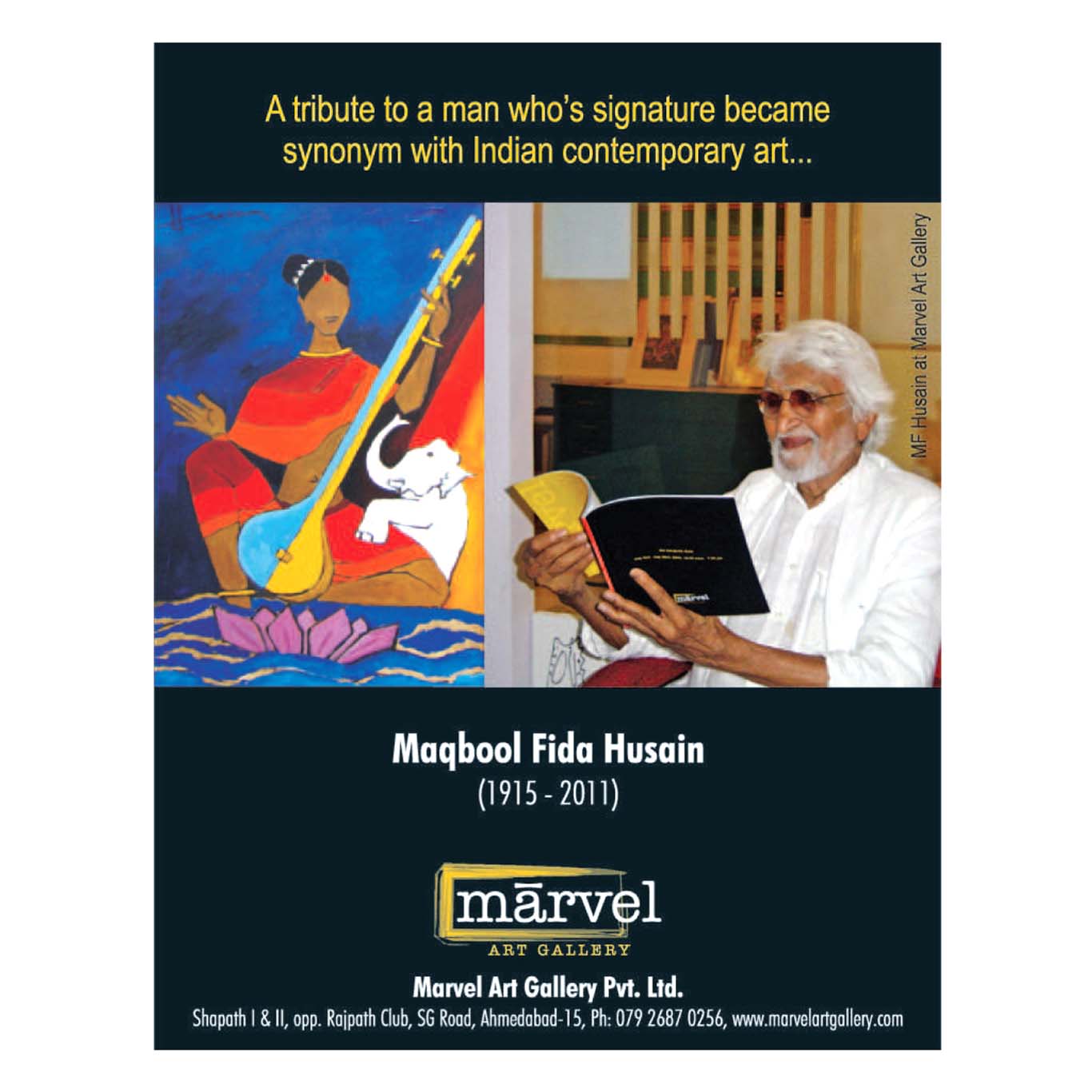
Marvel Art Gallery tribute to Maqbool Fida Husain. June 2011
Many images from that show still glow in memory. Sajal Sarkar showed Husain as the light of Indian art and as a popular icon. One work used a postage-stamp motif with the number ninety five, his age at passing, and included Husain’s iconic birds as a wish for peace and lasting presence. Sachin Nimbalkar hand-crafted a wooden chair and presented Husain as the maharaja of Indian art, with horses and familiar forms such as Gaja Gamini, the tiger and the blessing hand. Prithviraj Mali paid tribute with a mural of Bharat Mata and a pair of shoes with a rose and a lantern, a symbol that had a deep personal link to Husain. Preksha Kapadia painted Vidya Balan because Husain was fascinated by her and wanted to make a film with her. There was Ganesha. There was the Bugatti Veyron he bought in Dubai, among the first there. And there was the horse, of course. Harshil Patel titled his work A Game of the Art World and showed Husain as king through wooden playing cards. Bansi Khatri created a scroll titled Maqbul Nama that traced Husain from childhood to his last years, his subjects and series, the creation of the Ahmedabad Gufa, and his contributions to painting, architecture and cinema. It was a seven-artist exhibition with a deep and lasting impact.
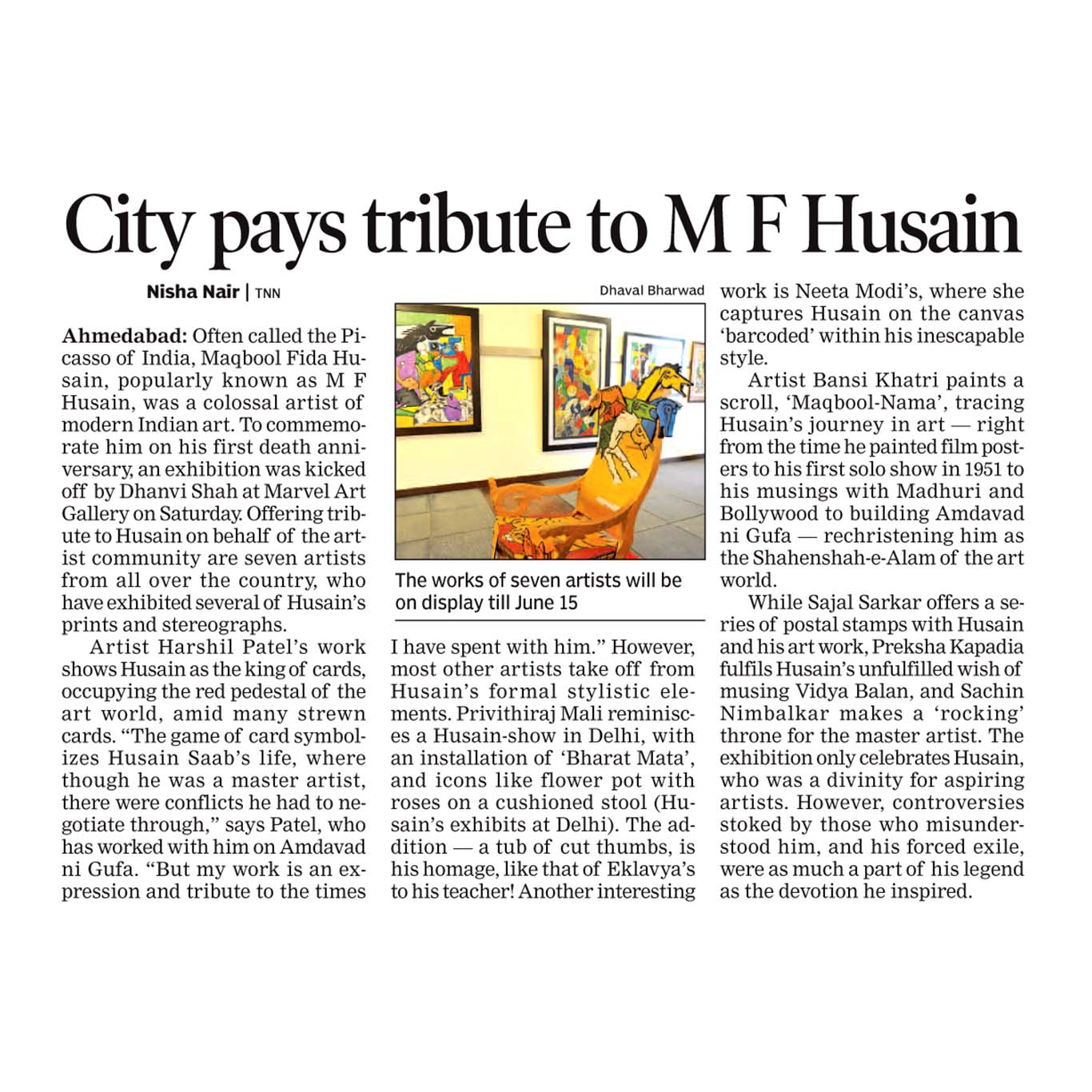
City Pays Tribute to MF Husain. By Nisha Nair, TNN. The Times of India (Ahmedabad). Published on June 10, 2012
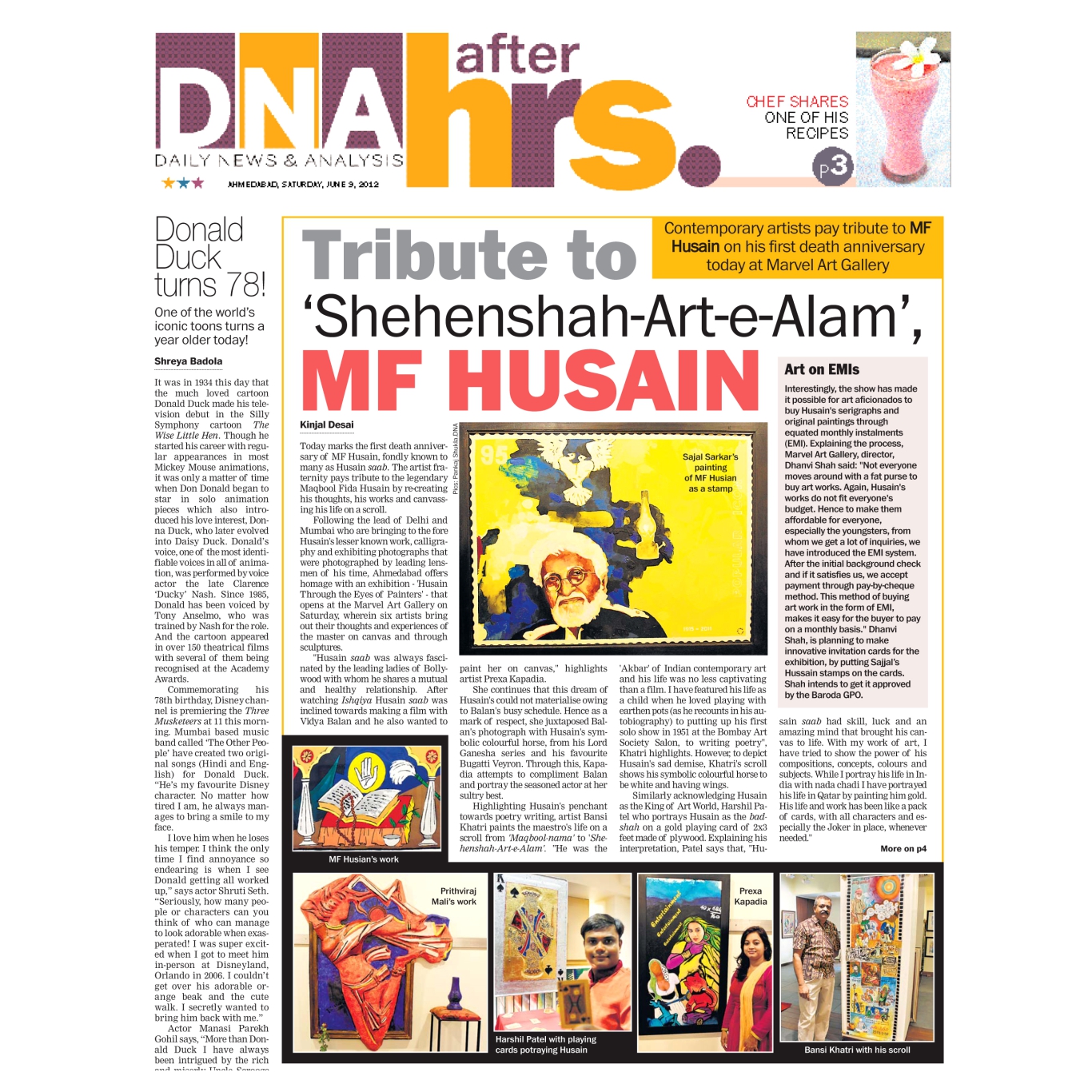
Tribute to “Shehenshah-Art-e-Alam,” MF Husain. By Kinjal Desai. DNA After Hrs (Ahmedabad). Published on June 9, 2012
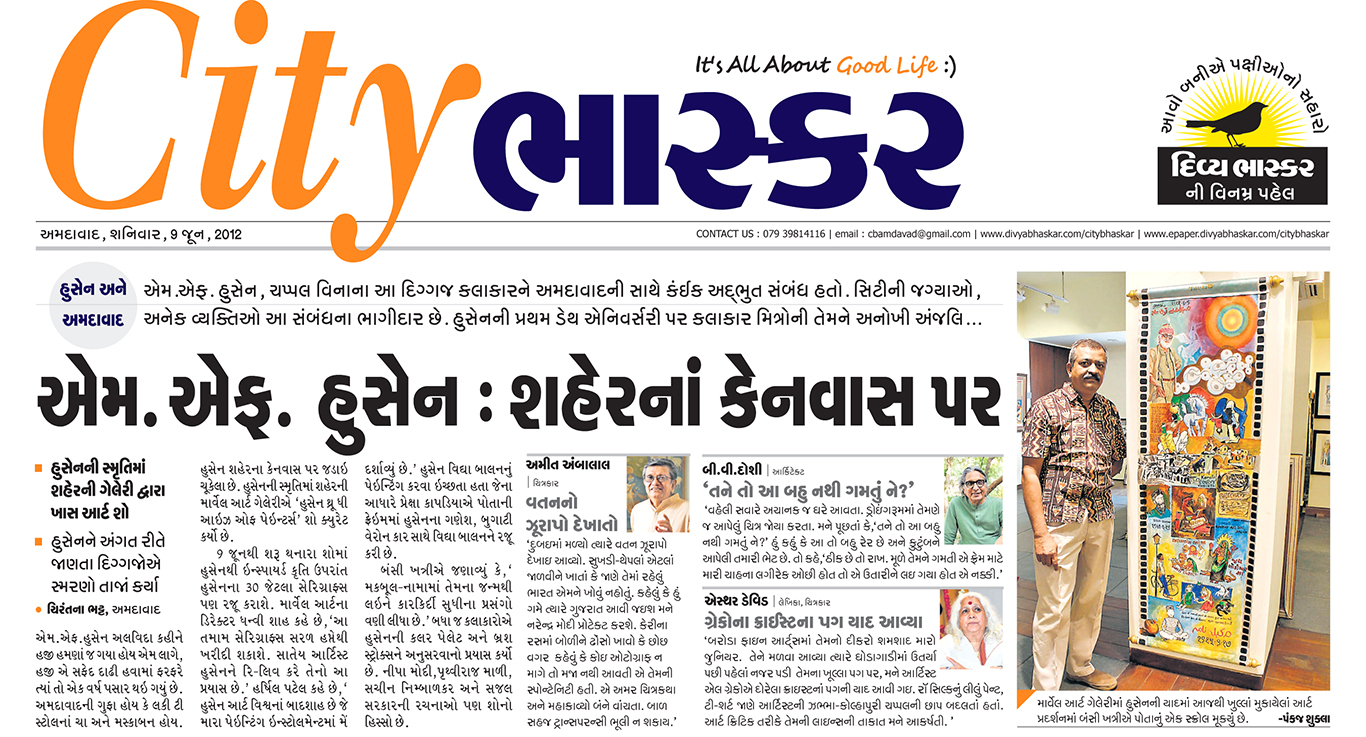
MF Husain: On the City’s Canvas. By Chintan Shah. Divya Bhaskar (City Bhaskar, Ahmedabad). Published on June 9, 2012
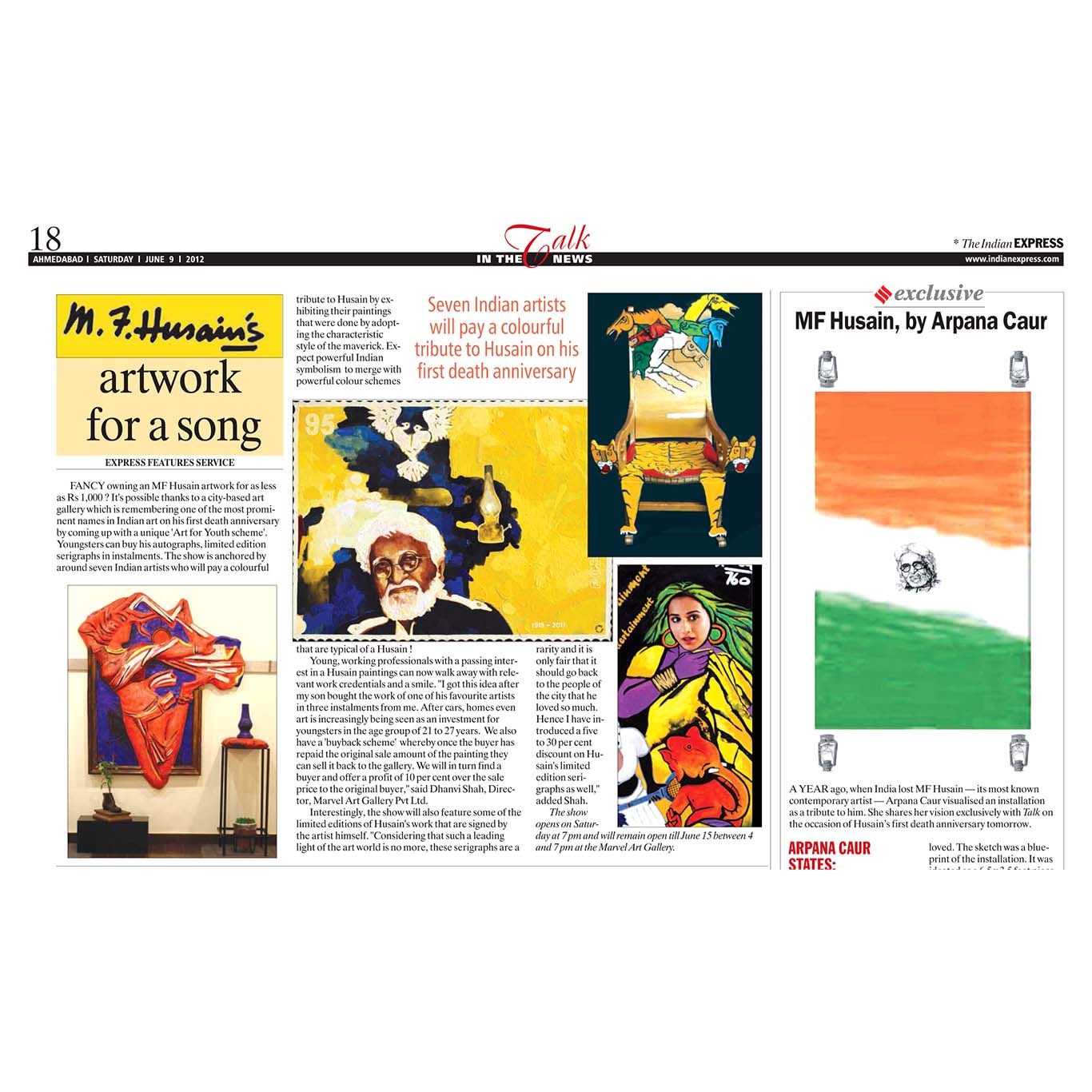
MF Husain’s Artwork for a Song. By Express Features Service. The Indian Express (Ahmedabad). Published on June 9, 2012
The cinema thread continued. The Gujarati film Bey Yaar wove a plot that echoed Husain. They used the name Hasan. Our artist Harshil Patel painted the idea, connecting it to the famous Lucky Tea Stall story where Husain gifted the owner a painting. The film echoed that real moment. We painted tea cups and a kettle and created the Lucky atmosphere in a painting about friendship. We exhibited it with the film’s cast and crew at the gallery. Through the exhibition and through the film, a popular medium, more people could enter the story. Bey Yaar remains one of the most successful Gujarati films. I am happy that not only the paintings but especially Husain’s story reached a larger public. All thanks to director Abhishek Jain for shaping a story with art at its centre, to Harshil Patel for the painting, and to my father, Dhanvi Shah for unwavering support for anything that promotes art.
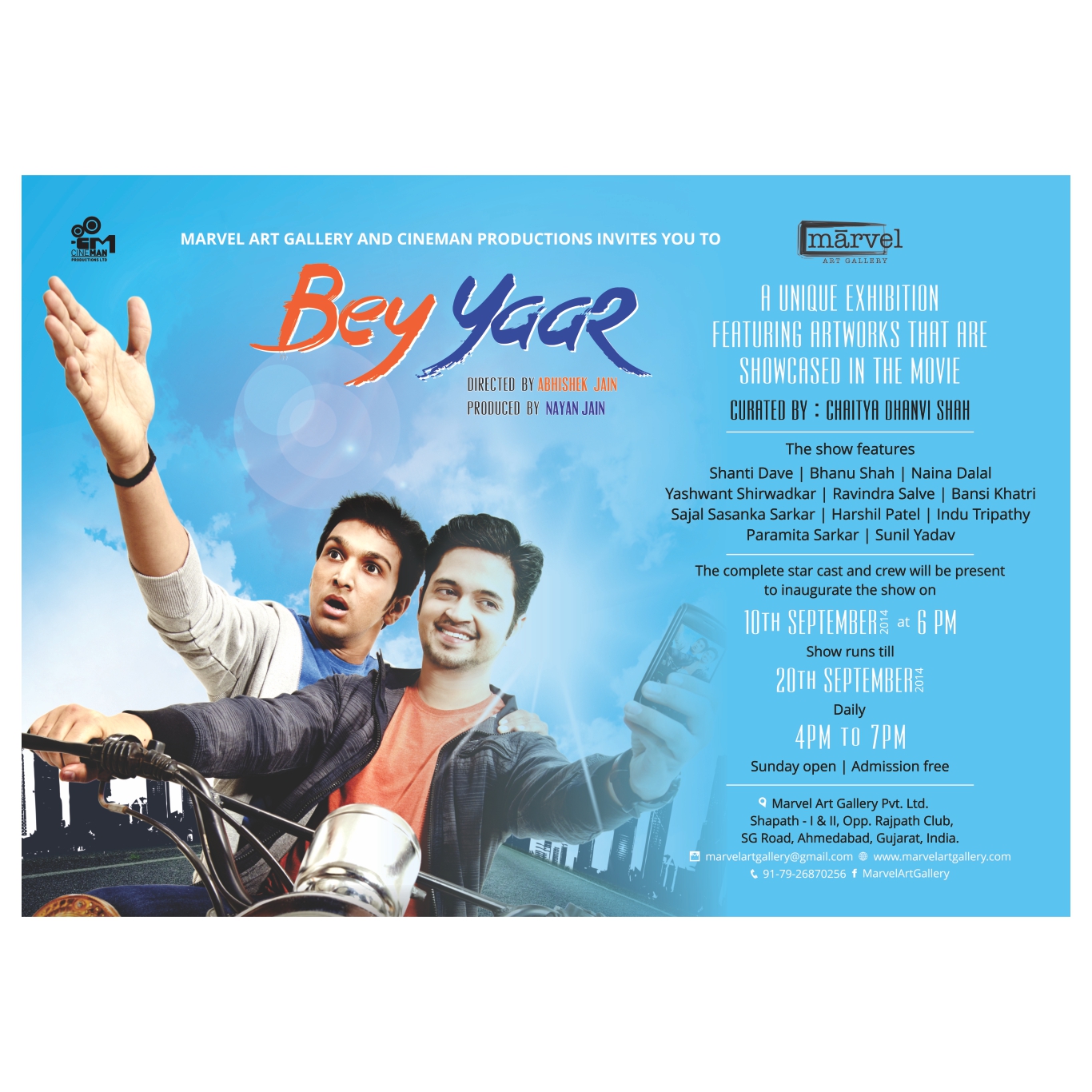
“Bey Yaar,” curated by Chaitya Dhanvi Shah. A special display of artworks seen in the movie at DRS Arts Company (formerly Marvel Art Gallery), Ahmedabad, 10–20 September 2014.
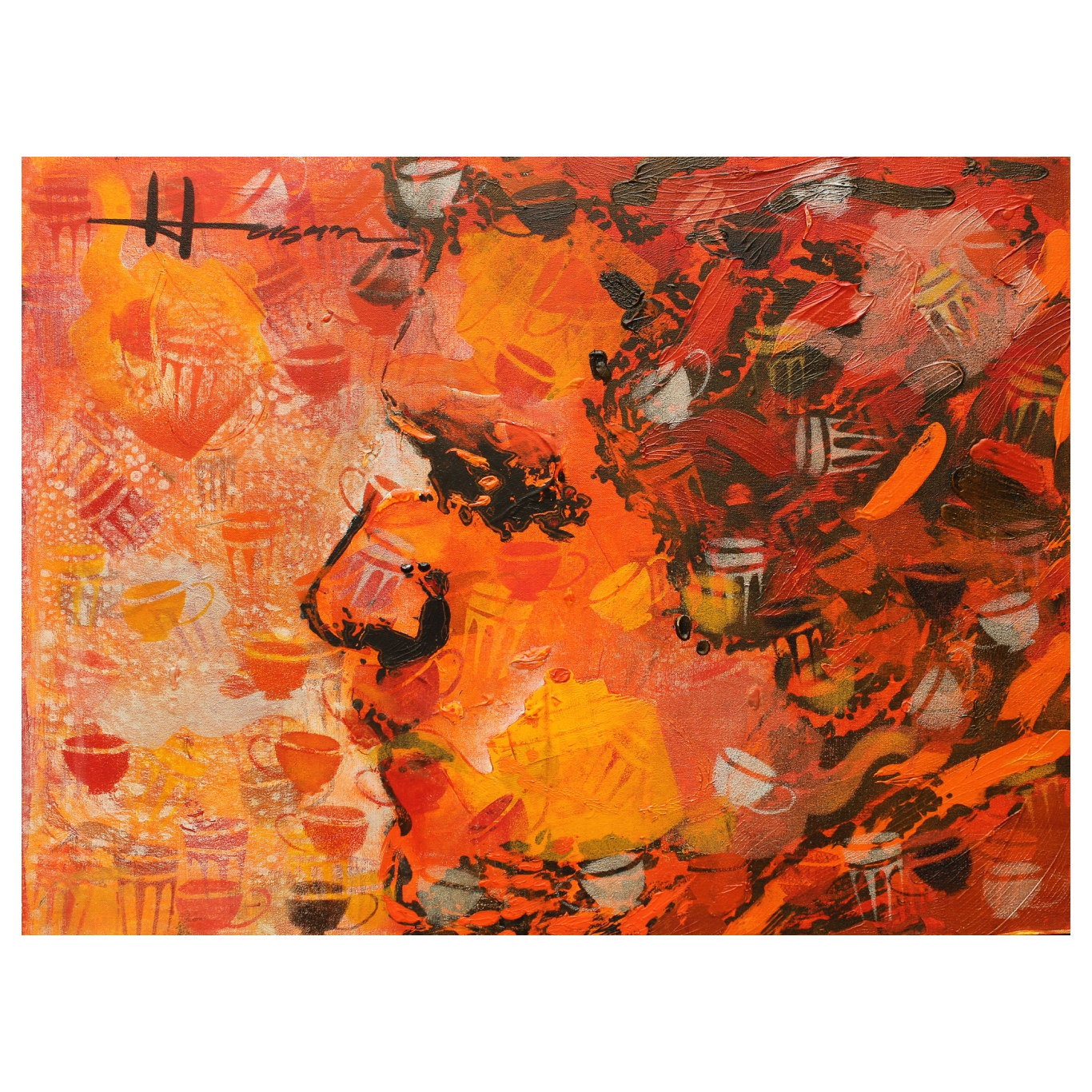
Friendship by Harshil Patel, created for the film “Bey Yaar.”
Husain at 110 what the world carries home
Years passed. Memories fade. Not much of Husain is heard around us today. It happens. Name and fame are not permanent. The artworks are. They remain.
With Husain @ 110 we celebrate his birthday, his contribution and, most importantly, the subjects he worked on through 110 editions. Serigraphs, reproductions, lithographs and more, irrespective of medium. They are authenticated because they come from DRS Arts Company. For anything before 2004, the work must be signed by him or published with his approval. We are presenting this at Rann Utsav for a larger and wider audience, both Indian and international, for people of all ages and classes. The idea is to let his art travel, to let his series and ideas travel, to let his contribution travel to a very large audience. Asia’s largest white desert welcomes people from across the world. They will see his journey, his works and the core of what he stood for.
In this way the world will see his works. Indians will reintroduce themselves to their own subjects. The world will carry India with them and Indians will carry a five-thousand-year civilisation with them. I hope they keep it in their hearts.
May he keep blessing Indian art in all forms. Modern and contemporary. Originals and editions. Printmaking, ceramic and sculpture. May the coming century belong to India and to Indian artists, galleries, curators, fairs and the entire art ecosystem.
Happy birthday, Maqbool Fida Husain.
Chaitya Dhanvi Shah
DRS Arts Company
17 September 2025
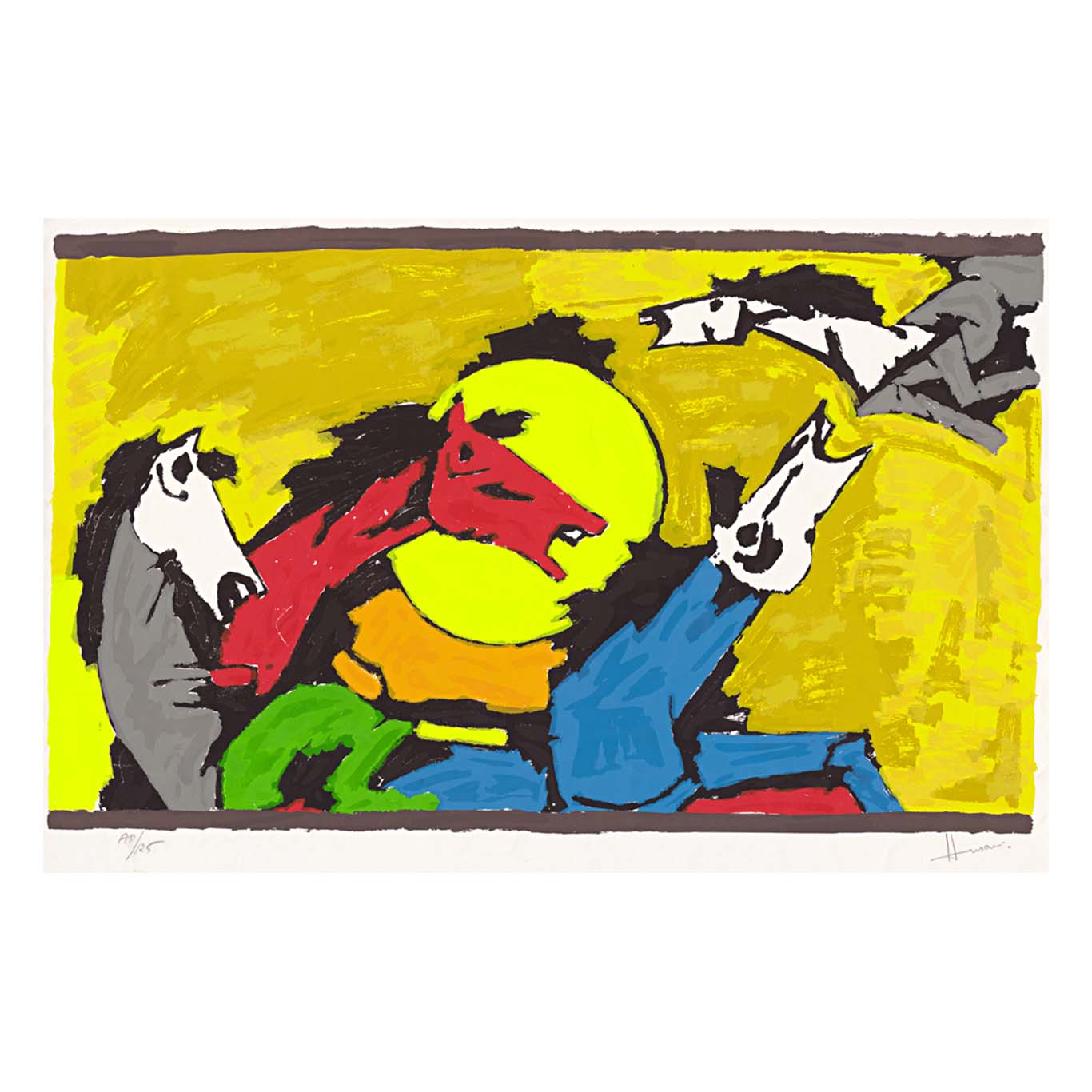
MF Husain, Horse, serigraph on paper, 2000, limited edition of 125
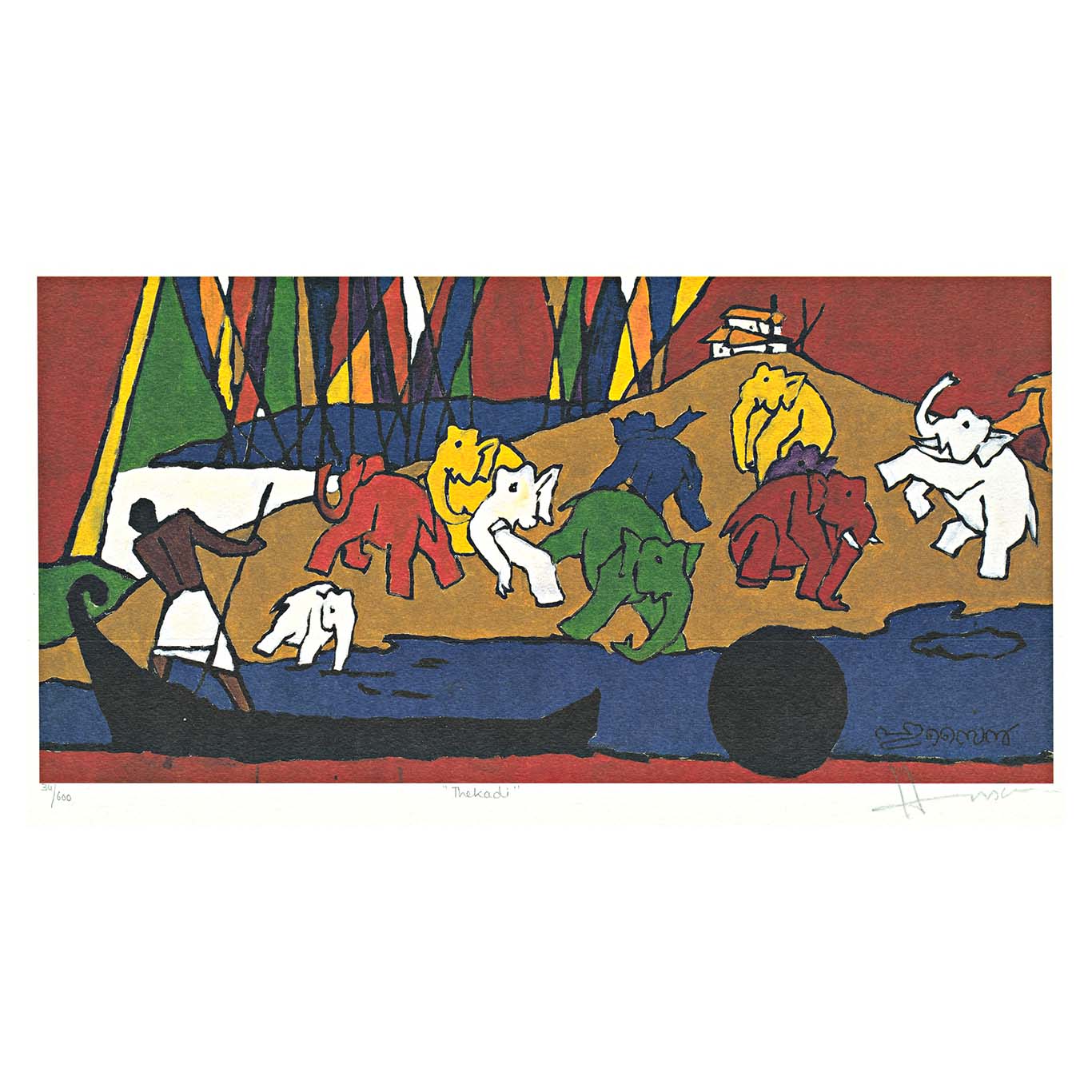
MF Husain, Kerala, Reproduction on paper, 2002, limited edition of 125
Photos and Text © Chaitya Dhanvi Shah


